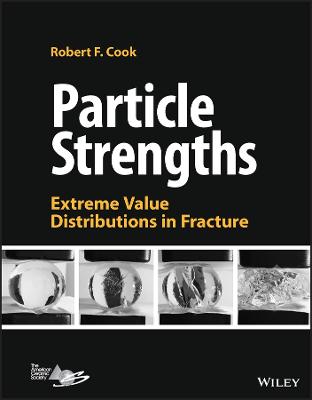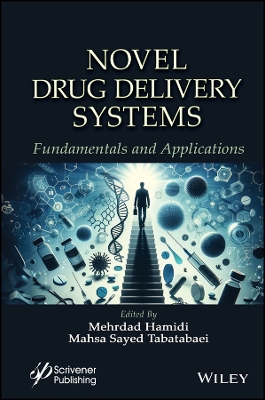Particle Strengths
 -15%
portes grátis
-15%
portes grátis
Particle Strengths
Extreme Value Distributions in Fracture
Cook, Robert F.
John Wiley & Sons Inc
02/2023
416
Dura
Inglês
9781119850939
15 a 20 dias
666
Descrição não disponível.
Preface xi
Abbreviations and Symbols xiii
1 Introduction to Particles and Particle Loading 1
1.1 Particle Failure and Human Activity 1
1.1.1 Particles as Structural Components 1
1.1.2 Particle Loading 4
1.1.3 Particles in Application 12
1.2 Particle Shapes and Sizes 14
1.3 Summary: Particle Loading and Shape 23
References 24
2 Particles in Diametral Compression 29
2.1 Extensive and Intensive Mechanical Properties 29
2.2 Particle Behavior in Diametral Compression 33
2.2.1 Force-Displacement Observations 33
2.2.2 Force-Displacement Models 38
2.3 Stress Analyses of Diametral Compression 48
2.4 Impact Loading 60
2.5 Strength Observations 63
2.6 Strength Empirical Distribution Function 65
2.7 Outline of Particle Strengths 68
2.7.1 Individual Topics 68
2.7.2 Overall Themes 70
References 72
3 Flaw Populations 81
3.1 Flaw Sizes and Strengths 81
3.2 Populations of Flaws and Strengths 84
3.2.1 Population Definitions 84
3.2.2 Population Examples 86
3.3 Samples of Flaws and Strengths 92
3.3.1 Sample Definitions 92
3.3.2 Sample Examples 96
3.4 Heavy-Tailed and Light-Tailed Populations 103
3.5 Discussion and Summary 106
References 110
4 Strength Distributions 113
4.1 Brittle Fracture Strengths 113
4.1.1 Samples of Components 113
4.1.2 Analysis of Sample Strength Distributions 114
4.2 Sample Strength Distributions 116
4.2.1 Sample Analysis Verification 116
4.2.2 Sample Examples 119
4.3 Discussion and Summary 125
References 130
5 Survey of Extended Component Strength Distributions 133
5.1 Introduction 133
5.2 Materials and Loading Survey 134
5.2.1 Glass, Bending and Pressure Loading 134
5.2.2 Alumina, Bending Loading 135
5.2.3 Silicon Nitride, Bending Loading 136
5.2.4 Porcelain, Bending Loading 138
5.2.5 Silicon, Bending and Tension Loading 140
5.2.6 Fibers, Tensile Loading 141
5.2.7 Shells, Flexure Loading 142
5.2.8 Columns, Compressive Loading 144
5.2.9 Materials Survey Summary 144
5.3 Size Effects 148
5.3.1 Stochastic 148
5.3.2 Deterministic 153
5.3.3 Size Effect Summary 159
5.4 Discussion and Summary 159
References 163
6 Survey of Particle Strength Distributions 167
6.1 Introduction 167
6.2 Materials Comparisons 169
6.2.1 Alumina 169
6.2.2 Quartz 171
6.2.3 Limestone 173
6.2.4 Rock 174
6.2.5 Threshold perturbations 175
6.3 Size Comparisons 177
6.3.1 Small Particles 177
6.3.2 Medium Particles 180
6.3.3 Large Particles 181
6.4 Summary and Discussion 182
References 186
7 Stochastic Scaling of Particle Strength Distributions 189
7.1 Introduction 189
7.2 Concave Stochastic Distributions 193
7.2.1 Alumina 193
7.2.2 Limestone 194
7.2.3 Coral 197
7.2.4 Quartz and Quartzite 198
7.2.5 Basalt 201
7.3 Sigmoidal Stochastic Distributions 202
7.3.1 Fertilizer 202
7.3.2 Glass 207
7.4 Summary and Discussion 208
References 213
8 Case Study: Strength Evolution in Ceramic Particles 215
8.1 Introduction 215
8.2 Strength and Flaw Size Observations 217
8.3 Strength and Flaw Size Analysis 220
8.4 Summary and Discussion 222
References 230
9 Deterministic Scaling of Particle Strength Distributions 233
9.1 Introduction 233
9.2 Concave Deterministic Distributions 237
9.2.1 Alumina 237
9.2.2 Quartz 238
9.2.3 Salt 241
9.2.4 Rock 242
9.2.5 Coal 245
9.2.6 Coral 246
9.3 Sigmoidal Deterministic Distributions 248
9.3.1 Glass 248
9.3.2 Rock 252
9.4 Linear Deterministic Distributions 253
9.4.1 Cement 254
9.4.2 Ice 257
9.5 Deterministic Strength and Flaw Size Analyses 258
9.5.1 Linear Strength Distributions 259
9.5.2 Concave Strength Distributions 263
9.6 Summary and Discussion 265
References 270
10 Agglomerate Particle Strengths 273
10.1 Introduction 273
10.2 Pharmaceuticals 276
10.2.1 Porosity 277
10.2.2 Shape 280
10.2.3 Distributions 287
10.3 Foods 290
10.4 Catalysts 292
10.5 Discussion and Summary 294
References 297
11 Compliant Particles 303
11.1 Introduction-Hydrogel Particles 303
11.2 Deformation 308
11.2.1 Axial 308
11.2.2 Transverse 310
11.3 Strength 315
11.4 Summary and Discussion 317
References 322
12 Fracture Mechanics of Particle Strengths 325
12.1 Introduction 325
12.2 Uniform Loading 327
12.2.1 Work and Elastic Energy 327
12.2.2 Mechanical Energy and Surface Energy 328
12.2.3 The Griffith Equation 329
12.2.4 Configurational Forces: G and R 331
12.3 Localized Loading 332
12.3.1 Analysis 332
12.3.2 Examples 334
12.4 Spatially Varying Loading 337
12.4.1 Stress-Intensity Factor and Toughness 337
12.4.2 Crack at a Stressed Pore 339
12.4.3 Crack at a Misfitting Inclusion 341
12.4.4 Crack at an Anisotropic Grain or Sharp Contact 347
12.5 Combined Loading 350
12.5.1 Strength of Post-Threshold Flaws 350
12.5.2 Strength of Sub-Threshold Flaws 353
12.6 Long Cracks in Particles 354
12.6.1 Polymer Discs 354
12.6.2 Microcellulose Tablets 358
12.6.3 Ductile-Brittle Transitions 359
12.6.4 Agglomerate Compaction 361
12.7 Discussion and Summary 363
References 366
13 Applications and Scaling of Particle Strengths 369
13.1 Introduction 369
13.2 Particle Crushing Energy 369
13.3 Grinding Particle Reliability 373
13.4 Mass Effects on Particle Strength 376
13.5 Microstructural Effects on Particle Strength 380
13.6 Discussion 388
References 390
Index 393
Abbreviations and Symbols xiii
1 Introduction to Particles and Particle Loading 1
1.1 Particle Failure and Human Activity 1
1.1.1 Particles as Structural Components 1
1.1.2 Particle Loading 4
1.1.3 Particles in Application 12
1.2 Particle Shapes and Sizes 14
1.3 Summary: Particle Loading and Shape 23
References 24
2 Particles in Diametral Compression 29
2.1 Extensive and Intensive Mechanical Properties 29
2.2 Particle Behavior in Diametral Compression 33
2.2.1 Force-Displacement Observations 33
2.2.2 Force-Displacement Models 38
2.3 Stress Analyses of Diametral Compression 48
2.4 Impact Loading 60
2.5 Strength Observations 63
2.6 Strength Empirical Distribution Function 65
2.7 Outline of Particle Strengths 68
2.7.1 Individual Topics 68
2.7.2 Overall Themes 70
References 72
3 Flaw Populations 81
3.1 Flaw Sizes and Strengths 81
3.2 Populations of Flaws and Strengths 84
3.2.1 Population Definitions 84
3.2.2 Population Examples 86
3.3 Samples of Flaws and Strengths 92
3.3.1 Sample Definitions 92
3.3.2 Sample Examples 96
3.4 Heavy-Tailed and Light-Tailed Populations 103
3.5 Discussion and Summary 106
References 110
4 Strength Distributions 113
4.1 Brittle Fracture Strengths 113
4.1.1 Samples of Components 113
4.1.2 Analysis of Sample Strength Distributions 114
4.2 Sample Strength Distributions 116
4.2.1 Sample Analysis Verification 116
4.2.2 Sample Examples 119
4.3 Discussion and Summary 125
References 130
5 Survey of Extended Component Strength Distributions 133
5.1 Introduction 133
5.2 Materials and Loading Survey 134
5.2.1 Glass, Bending and Pressure Loading 134
5.2.2 Alumina, Bending Loading 135
5.2.3 Silicon Nitride, Bending Loading 136
5.2.4 Porcelain, Bending Loading 138
5.2.5 Silicon, Bending and Tension Loading 140
5.2.6 Fibers, Tensile Loading 141
5.2.7 Shells, Flexure Loading 142
5.2.8 Columns, Compressive Loading 144
5.2.9 Materials Survey Summary 144
5.3 Size Effects 148
5.3.1 Stochastic 148
5.3.2 Deterministic 153
5.3.3 Size Effect Summary 159
5.4 Discussion and Summary 159
References 163
6 Survey of Particle Strength Distributions 167
6.1 Introduction 167
6.2 Materials Comparisons 169
6.2.1 Alumina 169
6.2.2 Quartz 171
6.2.3 Limestone 173
6.2.4 Rock 174
6.2.5 Threshold perturbations 175
6.3 Size Comparisons 177
6.3.1 Small Particles 177
6.3.2 Medium Particles 180
6.3.3 Large Particles 181
6.4 Summary and Discussion 182
References 186
7 Stochastic Scaling of Particle Strength Distributions 189
7.1 Introduction 189
7.2 Concave Stochastic Distributions 193
7.2.1 Alumina 193
7.2.2 Limestone 194
7.2.3 Coral 197
7.2.4 Quartz and Quartzite 198
7.2.5 Basalt 201
7.3 Sigmoidal Stochastic Distributions 202
7.3.1 Fertilizer 202
7.3.2 Glass 207
7.4 Summary and Discussion 208
References 213
8 Case Study: Strength Evolution in Ceramic Particles 215
8.1 Introduction 215
8.2 Strength and Flaw Size Observations 217
8.3 Strength and Flaw Size Analysis 220
8.4 Summary and Discussion 222
References 230
9 Deterministic Scaling of Particle Strength Distributions 233
9.1 Introduction 233
9.2 Concave Deterministic Distributions 237
9.2.1 Alumina 237
9.2.2 Quartz 238
9.2.3 Salt 241
9.2.4 Rock 242
9.2.5 Coal 245
9.2.6 Coral 246
9.3 Sigmoidal Deterministic Distributions 248
9.3.1 Glass 248
9.3.2 Rock 252
9.4 Linear Deterministic Distributions 253
9.4.1 Cement 254
9.4.2 Ice 257
9.5 Deterministic Strength and Flaw Size Analyses 258
9.5.1 Linear Strength Distributions 259
9.5.2 Concave Strength Distributions 263
9.6 Summary and Discussion 265
References 270
10 Agglomerate Particle Strengths 273
10.1 Introduction 273
10.2 Pharmaceuticals 276
10.2.1 Porosity 277
10.2.2 Shape 280
10.2.3 Distributions 287
10.3 Foods 290
10.4 Catalysts 292
10.5 Discussion and Summary 294
References 297
11 Compliant Particles 303
11.1 Introduction-Hydrogel Particles 303
11.2 Deformation 308
11.2.1 Axial 308
11.2.2 Transverse 310
11.3 Strength 315
11.4 Summary and Discussion 317
References 322
12 Fracture Mechanics of Particle Strengths 325
12.1 Introduction 325
12.2 Uniform Loading 327
12.2.1 Work and Elastic Energy 327
12.2.2 Mechanical Energy and Surface Energy 328
12.2.3 The Griffith Equation 329
12.2.4 Configurational Forces: G and R 331
12.3 Localized Loading 332
12.3.1 Analysis 332
12.3.2 Examples 334
12.4 Spatially Varying Loading 337
12.4.1 Stress-Intensity Factor and Toughness 337
12.4.2 Crack at a Stressed Pore 339
12.4.3 Crack at a Misfitting Inclusion 341
12.4.4 Crack at an Anisotropic Grain or Sharp Contact 347
12.5 Combined Loading 350
12.5.1 Strength of Post-Threshold Flaws 350
12.5.2 Strength of Sub-Threshold Flaws 353
12.6 Long Cracks in Particles 354
12.6.1 Polymer Discs 354
12.6.2 Microcellulose Tablets 358
12.6.3 Ductile-Brittle Transitions 359
12.6.4 Agglomerate Compaction 361
12.7 Discussion and Summary 363
References 366
13 Applications and Scaling of Particle Strengths 369
13.1 Introduction 369
13.2 Particle Crushing Energy 369
13.3 Grinding Particle Reliability 373
13.4 Mass Effects on Particle Strength 376
13.5 Microstructural Effects on Particle Strength 380
13.6 Discussion 388
References 390
Index 393
Este título pertence ao(s) assunto(s) indicados(s). Para ver outros títulos clique no assunto desejado.
Particle strength distributions; materials systems; strength distributions; particle strength measurements; particle strength textbook; particle strength book; particle strength text; particle strength in fracture; particle strength techniques; brittle fracture strength
Preface xi
Abbreviations and Symbols xiii
1 Introduction to Particles and Particle Loading 1
1.1 Particle Failure and Human Activity 1
1.1.1 Particles as Structural Components 1
1.1.2 Particle Loading 4
1.1.3 Particles in Application 12
1.2 Particle Shapes and Sizes 14
1.3 Summary: Particle Loading and Shape 23
References 24
2 Particles in Diametral Compression 29
2.1 Extensive and Intensive Mechanical Properties 29
2.2 Particle Behavior in Diametral Compression 33
2.2.1 Force-Displacement Observations 33
2.2.2 Force-Displacement Models 38
2.3 Stress Analyses of Diametral Compression 48
2.4 Impact Loading 60
2.5 Strength Observations 63
2.6 Strength Empirical Distribution Function 65
2.7 Outline of Particle Strengths 68
2.7.1 Individual Topics 68
2.7.2 Overall Themes 70
References 72
3 Flaw Populations 81
3.1 Flaw Sizes and Strengths 81
3.2 Populations of Flaws and Strengths 84
3.2.1 Population Definitions 84
3.2.2 Population Examples 86
3.3 Samples of Flaws and Strengths 92
3.3.1 Sample Definitions 92
3.3.2 Sample Examples 96
3.4 Heavy-Tailed and Light-Tailed Populations 103
3.5 Discussion and Summary 106
References 110
4 Strength Distributions 113
4.1 Brittle Fracture Strengths 113
4.1.1 Samples of Components 113
4.1.2 Analysis of Sample Strength Distributions 114
4.2 Sample Strength Distributions 116
4.2.1 Sample Analysis Verification 116
4.2.2 Sample Examples 119
4.3 Discussion and Summary 125
References 130
5 Survey of Extended Component Strength Distributions 133
5.1 Introduction 133
5.2 Materials and Loading Survey 134
5.2.1 Glass, Bending and Pressure Loading 134
5.2.2 Alumina, Bending Loading 135
5.2.3 Silicon Nitride, Bending Loading 136
5.2.4 Porcelain, Bending Loading 138
5.2.5 Silicon, Bending and Tension Loading 140
5.2.6 Fibers, Tensile Loading 141
5.2.7 Shells, Flexure Loading 142
5.2.8 Columns, Compressive Loading 144
5.2.9 Materials Survey Summary 144
5.3 Size Effects 148
5.3.1 Stochastic 148
5.3.2 Deterministic 153
5.3.3 Size Effect Summary 159
5.4 Discussion and Summary 159
References 163
6 Survey of Particle Strength Distributions 167
6.1 Introduction 167
6.2 Materials Comparisons 169
6.2.1 Alumina 169
6.2.2 Quartz 171
6.2.3 Limestone 173
6.2.4 Rock 174
6.2.5 Threshold perturbations 175
6.3 Size Comparisons 177
6.3.1 Small Particles 177
6.3.2 Medium Particles 180
6.3.3 Large Particles 181
6.4 Summary and Discussion 182
References 186
7 Stochastic Scaling of Particle Strength Distributions 189
7.1 Introduction 189
7.2 Concave Stochastic Distributions 193
7.2.1 Alumina 193
7.2.2 Limestone 194
7.2.3 Coral 197
7.2.4 Quartz and Quartzite 198
7.2.5 Basalt 201
7.3 Sigmoidal Stochastic Distributions 202
7.3.1 Fertilizer 202
7.3.2 Glass 207
7.4 Summary and Discussion 208
References 213
8 Case Study: Strength Evolution in Ceramic Particles 215
8.1 Introduction 215
8.2 Strength and Flaw Size Observations 217
8.3 Strength and Flaw Size Analysis 220
8.4 Summary and Discussion 222
References 230
9 Deterministic Scaling of Particle Strength Distributions 233
9.1 Introduction 233
9.2 Concave Deterministic Distributions 237
9.2.1 Alumina 237
9.2.2 Quartz 238
9.2.3 Salt 241
9.2.4 Rock 242
9.2.5 Coal 245
9.2.6 Coral 246
9.3 Sigmoidal Deterministic Distributions 248
9.3.1 Glass 248
9.3.2 Rock 252
9.4 Linear Deterministic Distributions 253
9.4.1 Cement 254
9.4.2 Ice 257
9.5 Deterministic Strength and Flaw Size Analyses 258
9.5.1 Linear Strength Distributions 259
9.5.2 Concave Strength Distributions 263
9.6 Summary and Discussion 265
References 270
10 Agglomerate Particle Strengths 273
10.1 Introduction 273
10.2 Pharmaceuticals 276
10.2.1 Porosity 277
10.2.2 Shape 280
10.2.3 Distributions 287
10.3 Foods 290
10.4 Catalysts 292
10.5 Discussion and Summary 294
References 297
11 Compliant Particles 303
11.1 Introduction-Hydrogel Particles 303
11.2 Deformation 308
11.2.1 Axial 308
11.2.2 Transverse 310
11.3 Strength 315
11.4 Summary and Discussion 317
References 322
12 Fracture Mechanics of Particle Strengths 325
12.1 Introduction 325
12.2 Uniform Loading 327
12.2.1 Work and Elastic Energy 327
12.2.2 Mechanical Energy and Surface Energy 328
12.2.3 The Griffith Equation 329
12.2.4 Configurational Forces: G and R 331
12.3 Localized Loading 332
12.3.1 Analysis 332
12.3.2 Examples 334
12.4 Spatially Varying Loading 337
12.4.1 Stress-Intensity Factor and Toughness 337
12.4.2 Crack at a Stressed Pore 339
12.4.3 Crack at a Misfitting Inclusion 341
12.4.4 Crack at an Anisotropic Grain or Sharp Contact 347
12.5 Combined Loading 350
12.5.1 Strength of Post-Threshold Flaws 350
12.5.2 Strength of Sub-Threshold Flaws 353
12.6 Long Cracks in Particles 354
12.6.1 Polymer Discs 354
12.6.2 Microcellulose Tablets 358
12.6.3 Ductile-Brittle Transitions 359
12.6.4 Agglomerate Compaction 361
12.7 Discussion and Summary 363
References 366
13 Applications and Scaling of Particle Strengths 369
13.1 Introduction 369
13.2 Particle Crushing Energy 369
13.3 Grinding Particle Reliability 373
13.4 Mass Effects on Particle Strength 376
13.5 Microstructural Effects on Particle Strength 380
13.6 Discussion 388
References 390
Index 393
Abbreviations and Symbols xiii
1 Introduction to Particles and Particle Loading 1
1.1 Particle Failure and Human Activity 1
1.1.1 Particles as Structural Components 1
1.1.2 Particle Loading 4
1.1.3 Particles in Application 12
1.2 Particle Shapes and Sizes 14
1.3 Summary: Particle Loading and Shape 23
References 24
2 Particles in Diametral Compression 29
2.1 Extensive and Intensive Mechanical Properties 29
2.2 Particle Behavior in Diametral Compression 33
2.2.1 Force-Displacement Observations 33
2.2.2 Force-Displacement Models 38
2.3 Stress Analyses of Diametral Compression 48
2.4 Impact Loading 60
2.5 Strength Observations 63
2.6 Strength Empirical Distribution Function 65
2.7 Outline of Particle Strengths 68
2.7.1 Individual Topics 68
2.7.2 Overall Themes 70
References 72
3 Flaw Populations 81
3.1 Flaw Sizes and Strengths 81
3.2 Populations of Flaws and Strengths 84
3.2.1 Population Definitions 84
3.2.2 Population Examples 86
3.3 Samples of Flaws and Strengths 92
3.3.1 Sample Definitions 92
3.3.2 Sample Examples 96
3.4 Heavy-Tailed and Light-Tailed Populations 103
3.5 Discussion and Summary 106
References 110
4 Strength Distributions 113
4.1 Brittle Fracture Strengths 113
4.1.1 Samples of Components 113
4.1.2 Analysis of Sample Strength Distributions 114
4.2 Sample Strength Distributions 116
4.2.1 Sample Analysis Verification 116
4.2.2 Sample Examples 119
4.3 Discussion and Summary 125
References 130
5 Survey of Extended Component Strength Distributions 133
5.1 Introduction 133
5.2 Materials and Loading Survey 134
5.2.1 Glass, Bending and Pressure Loading 134
5.2.2 Alumina, Bending Loading 135
5.2.3 Silicon Nitride, Bending Loading 136
5.2.4 Porcelain, Bending Loading 138
5.2.5 Silicon, Bending and Tension Loading 140
5.2.6 Fibers, Tensile Loading 141
5.2.7 Shells, Flexure Loading 142
5.2.8 Columns, Compressive Loading 144
5.2.9 Materials Survey Summary 144
5.3 Size Effects 148
5.3.1 Stochastic 148
5.3.2 Deterministic 153
5.3.3 Size Effect Summary 159
5.4 Discussion and Summary 159
References 163
6 Survey of Particle Strength Distributions 167
6.1 Introduction 167
6.2 Materials Comparisons 169
6.2.1 Alumina 169
6.2.2 Quartz 171
6.2.3 Limestone 173
6.2.4 Rock 174
6.2.5 Threshold perturbations 175
6.3 Size Comparisons 177
6.3.1 Small Particles 177
6.3.2 Medium Particles 180
6.3.3 Large Particles 181
6.4 Summary and Discussion 182
References 186
7 Stochastic Scaling of Particle Strength Distributions 189
7.1 Introduction 189
7.2 Concave Stochastic Distributions 193
7.2.1 Alumina 193
7.2.2 Limestone 194
7.2.3 Coral 197
7.2.4 Quartz and Quartzite 198
7.2.5 Basalt 201
7.3 Sigmoidal Stochastic Distributions 202
7.3.1 Fertilizer 202
7.3.2 Glass 207
7.4 Summary and Discussion 208
References 213
8 Case Study: Strength Evolution in Ceramic Particles 215
8.1 Introduction 215
8.2 Strength and Flaw Size Observations 217
8.3 Strength and Flaw Size Analysis 220
8.4 Summary and Discussion 222
References 230
9 Deterministic Scaling of Particle Strength Distributions 233
9.1 Introduction 233
9.2 Concave Deterministic Distributions 237
9.2.1 Alumina 237
9.2.2 Quartz 238
9.2.3 Salt 241
9.2.4 Rock 242
9.2.5 Coal 245
9.2.6 Coral 246
9.3 Sigmoidal Deterministic Distributions 248
9.3.1 Glass 248
9.3.2 Rock 252
9.4 Linear Deterministic Distributions 253
9.4.1 Cement 254
9.4.2 Ice 257
9.5 Deterministic Strength and Flaw Size Analyses 258
9.5.1 Linear Strength Distributions 259
9.5.2 Concave Strength Distributions 263
9.6 Summary and Discussion 265
References 270
10 Agglomerate Particle Strengths 273
10.1 Introduction 273
10.2 Pharmaceuticals 276
10.2.1 Porosity 277
10.2.2 Shape 280
10.2.3 Distributions 287
10.3 Foods 290
10.4 Catalysts 292
10.5 Discussion and Summary 294
References 297
11 Compliant Particles 303
11.1 Introduction-Hydrogel Particles 303
11.2 Deformation 308
11.2.1 Axial 308
11.2.2 Transverse 310
11.3 Strength 315
11.4 Summary and Discussion 317
References 322
12 Fracture Mechanics of Particle Strengths 325
12.1 Introduction 325
12.2 Uniform Loading 327
12.2.1 Work and Elastic Energy 327
12.2.2 Mechanical Energy and Surface Energy 328
12.2.3 The Griffith Equation 329
12.2.4 Configurational Forces: G and R 331
12.3 Localized Loading 332
12.3.1 Analysis 332
12.3.2 Examples 334
12.4 Spatially Varying Loading 337
12.4.1 Stress-Intensity Factor and Toughness 337
12.4.2 Crack at a Stressed Pore 339
12.4.3 Crack at a Misfitting Inclusion 341
12.4.4 Crack at an Anisotropic Grain or Sharp Contact 347
12.5 Combined Loading 350
12.5.1 Strength of Post-Threshold Flaws 350
12.5.2 Strength of Sub-Threshold Flaws 353
12.6 Long Cracks in Particles 354
12.6.1 Polymer Discs 354
12.6.2 Microcellulose Tablets 358
12.6.3 Ductile-Brittle Transitions 359
12.6.4 Agglomerate Compaction 361
12.7 Discussion and Summary 363
References 366
13 Applications and Scaling of Particle Strengths 369
13.1 Introduction 369
13.2 Particle Crushing Energy 369
13.3 Grinding Particle Reliability 373
13.4 Mass Effects on Particle Strength 376
13.5 Microstructural Effects on Particle Strength 380
13.6 Discussion 388
References 390
Index 393
Este título pertence ao(s) assunto(s) indicados(s). Para ver outros títulos clique no assunto desejado.







